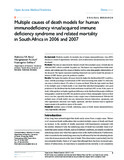Please use this identifier to cite or link to this item:
http://hdl.handle.net/10311/1071Full metadata record
| DC Field | Value | Language |
|---|---|---|
| dc.contributor.author | Amey, KA.A. | - |
| dc.contributor.author | Forcheh, N. | - |
| dc.contributor.author | Setlhare, K. | - |
| dc.date.accessioned | 2012-11-21T10:29:00Z | - |
| dc.date.available | 2012-11-21T10:29:00Z | - |
| dc.date.issued | 2012 | - |
| dc.identifier.citation | Amey, A.KA et.al (2012) Multiple causes of death models for human immunodeficiency virus/acquired immune deficiency syndrome and related mortality in South Africa in 2006 and 2007, Open Access Medical Statistics, Vol. 2, pp. 1-13 | en_US |
| dc.identifier.uri | http://hdl.handle.net/10311/1071 | - |
| dc.description.abstract | Background: Predictive models for mortality due to human immunodeficiency virus (HIV) disease as a result of opportunistic infections, such as tuberculosis and pneumonia, have been developed. Methods: The data are taken from the Statistics South Africa multiple causes of death data for 2006 and 2007, which is available for public use. The dataset was compiled from death notifications, and contains up to five causes of death as well as some demographic characteristics of the deceased. The logistic regression modeling framework was used to model the presence or absence of HIV disease, given the predictive variables. Results: The higher the number of causes listed, the higher the likelihood that HIV would be a cause, with the percentage of notifications of HIV listed increasing from under 2% when only one cause is listed to almost 15% when 4–5 causes are listed. When the logit model was fitted to the multiple cause of death model, it was found that individual demographics were good predictors of the likelihood that the death notification would have HIV as one of the causes of death. Although there are highly significant differences in the likelihood that people of different demographics would die from HIV, the predictive power of these demographic factors on their own is very low, especially when there is only a single cause of death mentioned. With the full multiple cause of death model, two-way interactions between tuberculosis, pneumonia, and other opportunistic infections were highly significant, and their inclusion lead to significant improvements in the predictive power of the model. | en_US |
| dc.language.iso | en | en_US |
| dc.publisher | Dove Medical Press Ltd. www.dovepress.com/ | en_US |
| dc.subject | Multiple causes of death | en_US |
| dc.subject | Underlying causes of death | en_US |
| dc.subject | Human immunodeficiency virus | en_US |
| dc.subject | Logit model | en_US |
| dc.subject | Odd ratios | en_US |
| dc.subject.lcsh | Human immunodeficiency virus--South Africa | en_US |
| dc.title | Multiple causes of death models for human immunodeficiency virus/acquired immune deficiency syndrome and related mortality in South Africa in 2006 and 2007 | en_US |
| dc.type | Published Article | en_US |
| dc.link | http://www.dovepress.com/getfile.php?fileID=11860 | en_US |
| Appears in Collections: | Research articles (Dept of Statistics) | |
Files in This Item:
| File | Description | Size | Format | |
|---|---|---|---|---|
| Forcheh_OAMS_2012.pdf | 295.65 kB | Adobe PDF |  View/Open |
Items in DSpace are protected by copyright, with all rights reserved, unless otherwise indicated.
